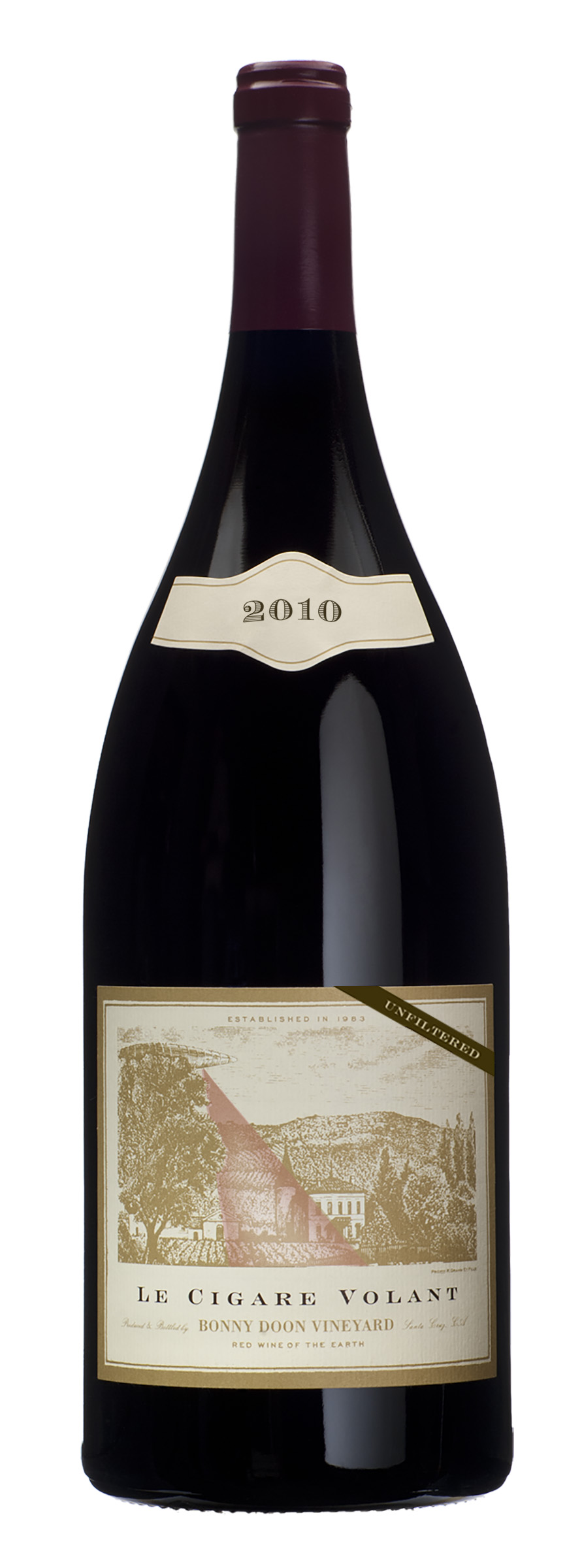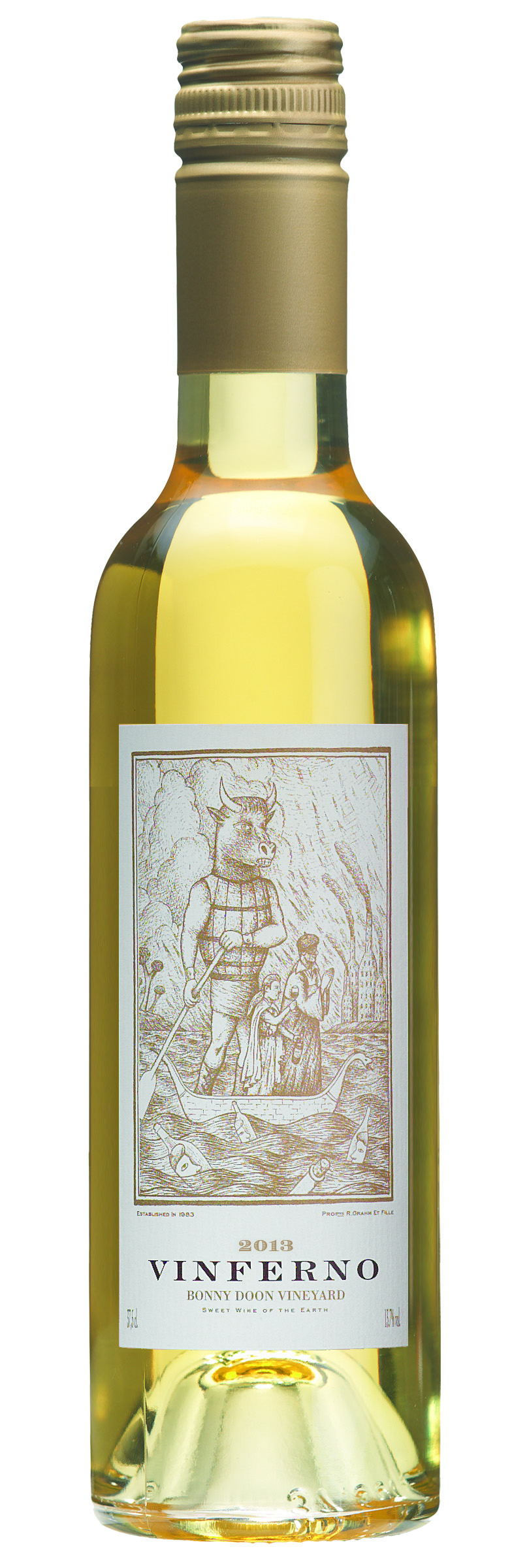Randall Grahm's
Bonny Doon Vineyard has been providing holiday-worthy wines for more years than I have been drinking them - at least more years than I have been obsessed with them.
Grahm - the eloquent Rhône Ranger - has his own obsessions with which to grapple. A pioneering spirit if there ever was one, he is currently obsessed with
growing grapevines from seeds, rather than from cuttings. His experimentation in that arena is rather new, so there's nothing to report. Yet.
Being late in the year, he has been keeping himself busy lately with the rigors of harvest and the business of bottling his latest releases. It is those we put forth as suggestions for your holiday table - or your holiday chair, if you prefer. The man's wines are not only a cinch to pair well with food, but they also go down real well in sipping and thinking mode.
From his recent email, all descriptions by Grahm:
"Harvest 2014 came and went like a freight train through California, and apart from apocalyptic intimations of drought-related devastation/ruination, it was a very good, relatively abundant, if not preternaturally early vintage.
2013 Le Cigare Blanc, "Beeswax Vineyard" $28
(55% Roussanne, 26% Grenache Blanc, 19% Picpoul) We've made a very slight label change with this vintage. An echo of the mineral character that we were able to express in the wonderful '11, but perhaps a tad richer on the palate. 1,965 cases produced.
2012 Syrah, "Le Pousseur" $26
(48% Alamo Creek, 18% Bien Nacido, 18% Spanish Springs, 16% Ventana) From a number of cool climate sites, a fair amount of whole clusters included, this is a savory Syrah of great restraint. 2,126 cases produced.
2013 Clos de Gilroy $20
(75% Grenache, 17% Syrah, 8% Mourvèdre) Grenache from the impeccable Alta Loma vineyard in the Arroyo Seco (a relatively cool site in every sense), a rather textbook Grenache, with a lovely mineral aspect. 3,400 cases produced.
2013 A Proper Claret $16
(46% Cabernet Sauvignon, 17% Merlot, 15% Tannat, 13.5% Petit Verdot, 7.7% Syrah, .8% Petite Sirah) Nothing of course "proper" about this wine; it is the febrile imagining of what a restrained, elegant Cabernet-based wine might taste like in the New World. 15,920 cases produced.
2010 Le Cigare Volant $45
(28% Syrah, 22% Grenache, 17% Cinsault, 17% Mourvèdre, 16% Carignane) Continuing in our series of "Burgundian" vintages of Cigare with old-vine Cinsault playing a very important role in keeping the Syrah in check. Yes, Carignane ain't a proper grape for faux-Châteauneuf. We knew that, (but it does provide the wine a nice steely exoskeleton). 1,344 cases produced.
2010 Le Cigare Volant Réserve, "En bonbonne" $79
This wine began life as precisely the same wine as the "normale," but was subject to élevage in glass, which has imparted a most unusual textural element and a great degree of savoriness. (Yeast lees are very rich in glutamate.) 547 cases produced.
2012 Contra $18
(56% Carignane, 17% Syrah, 15% Grenache, 11% Mourvèdre, 1% Cinsault) Some (former) colleagues and wholesalers were not so keen about the old "couch label" and persuaded me to change it to something a bit slicker and more commercial (perhaps too kool for skool?). We added a bit of cool climate syrah and grenache to the very old vine Carignane and Mourvèdre.4,720 cases produced.
2012 Grenache, "Cuvée R" $48
This is a "special" selection of Grenache grown at what was formerly our "Ca' del Solo" Vineyard in Soledad, and is available exclusively to our DEWN Club members. It seems to produce an extremely complex and concentrated Grenache. (We're planting it at our new vineyard in San Juan Bautista and it looks incredibly promising). 593 cases produced.
2011 Syrah, "Bien Nacido Vyd., Block X" $50
The ultra-consistent older Block X, planted with the "Estrella River" clone of Syrah (I suspect without any foundational evidence that it may actually be "Serine"), produces an extremely peppery, bacon-fat version of Syrah, far more consistently than modern clones. 463 cases produced.
2013 The Heart Has its Rieslings $16
(52% San Benito County, 48% Monterey County) From the Wirz Vineyard in San Benito and the Ventana Vineyard in the Arroyo Seco, this is a Kabinett style with 3% residual sugar. 2,912 cases produced.
2013 Vinferno $24/375 ml.
(100% Grenache Blanc) Not air-dried, frozen or botrytised, this is just very late harvested Grenache Blanc, but has appropriately enough, taken on a certain honeyed/beeswax character. 987 cases produced.
2011 Sparkling Syrah $36
(Méthode traditionelle) It's lately been an aspiration of mine to explore the wine styles that are most challenging to me. I've always adored the idea of Sparkling Syrah (or Shiraz), but even James Halliday couldn't find one that I could abide. Maybe it's maturation on my part or just a sudden shift in consciousness, but this is one I adore. Only one small caveat: The wine is very, very fizzy, so please open with caution. 378 cases produced."
Randall Grahm
Bonny Doon Vineyard
1-888-819-6789
Tasting Room: 450 Highway 1, Davenport, CA 95041
Follow Randy Fuller on Twitter


















